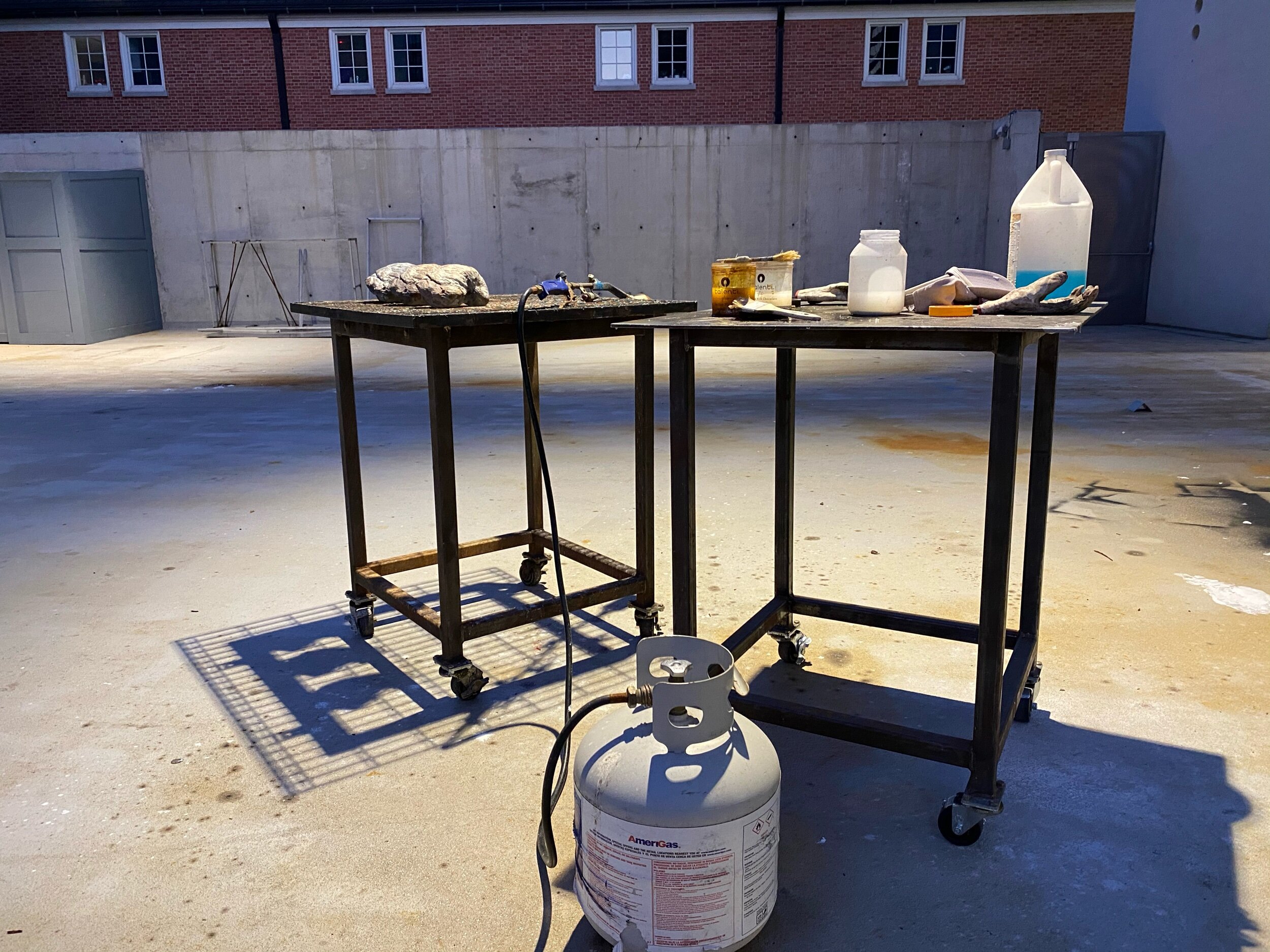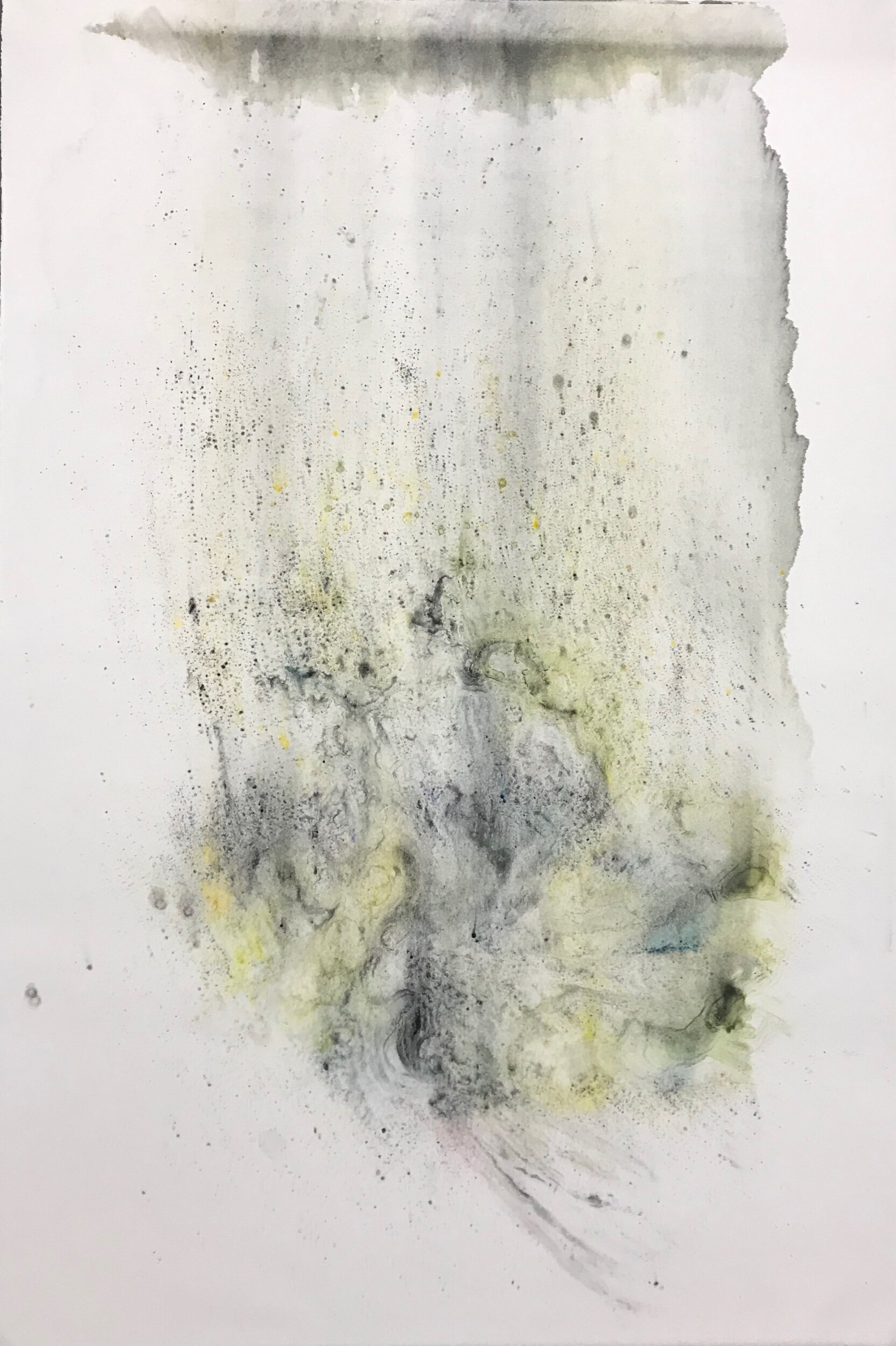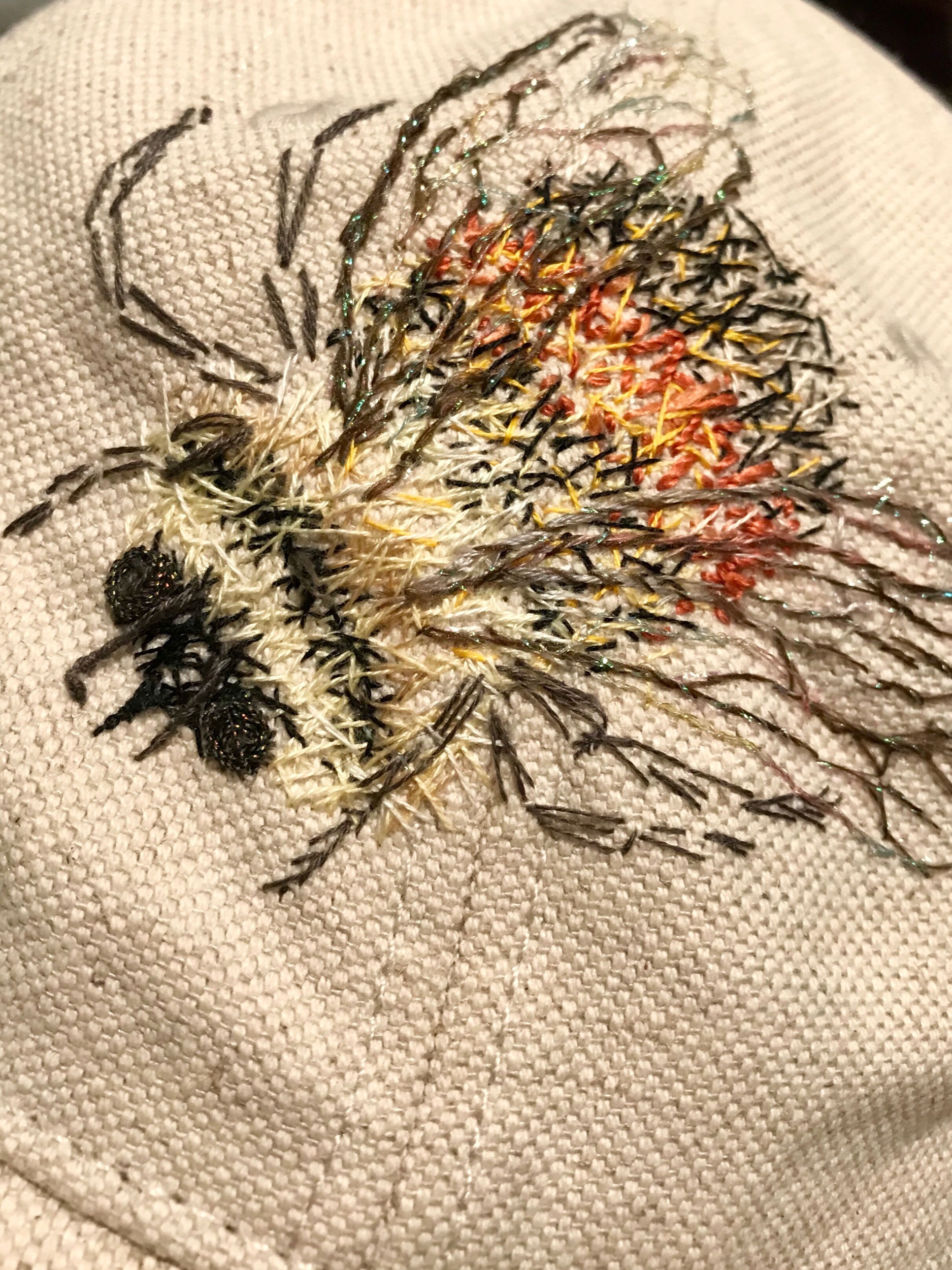Ready set torch
One for Griffin and Alex, one for Sage and Cameron one to $$$$
Each one us individually signed
I applied a darker patina on the chipped edge.
Your Custom Text Here

Ready set torch

One for Griffin and Alex, one for Sage and Cameron one to $$$$

Each one us individually signed

I applied a darker patina on the chipped edge.





Studying our past is an incredible learning tool. With that in mind, I found the below article about the oldest bee fossil.
https://www.livescience.com/amp/4255-oldest-bee-fossil-creates-buzz.html
https://tmm.utexas.edu/sites/default/files/Amber%20Activity%202019.pdf
Coincidentally I just made a mold of a fossil for personal reasons. Reading this article is inspiring some new ideas that will involve the fossil mold and bees.

Osmia Texana - The Berry Bee This frantic bee is about as big as a housefly. If you look at one with a macro lens you can see they are a beautiful metallic blue. The underside of their abdomen is a fuzzy pollen mop. These pollen magnets are the perfect shape to collect pollen from blueberries, raspberries, strawberries, melons, and veggies, to name a few. They are not picky pollinators.
A single Texana Bee frantically visits 20,000+ blossoms per day, whereas a honey bee visits 50-1000. They are not- aggressive and non-colonizing, solitary bees.
They emerge in the spring and have an average pollinating season of 6-8 weeks, after which they die. Their offspring will hibernate over the winter and emerge the following spring.
They are found on both the central and North American continent.

Watercolor monotype 44” X 30.”

The ghost
30” X 44” Lenticular in In the words of Paul Mc Cartney and the Beatles in “Let it Be” I think of Mother Mary as mother nature. Some day I would like to have a children’s choir sing “Let it Be” with my shadow piece,” World of Hum.”. But for now it is Spotify and a lenticular in my studio.
I give these hand stitched caps to people that help me make an impact and bring back the endangered wild bees.
Bombus Affinis, the Rusty Patch Bumble bee was listed as Endangered January 11, 2017.

A great resource for learning about native bees is below.
https://xerces.org/wp-content/uploads/2016/10/2017-009_B-affinis_IDGuide_web.pdf
Things are now going smoothly maybe too smoothly. All the work I did this summer is paying off.
ps. I now have the equivalent of another silo full of work in my studio………. bursting at the seems. Anyone need a keystone animal environmental installation?


This summer, I made 7 sections of kinetic sculptures, approximately 6’-10’ long X 36” in diameter, anticipating that I would not use all of them. Now that I am in the space and see what the light does on the convex wall, I think I will use 4 of my favorite sections and add 4 extra lines dropped for smaller pieces that will help integrate the 4 sections into one piece.

Experimenting with the placement of the light.

Experimenting with the shadows with the light in a convex wall.

The walls are not "museum pristine", they show their age, I am not bothered, it is a grain silo and I ❤️ It.

Close up of support system

The moment I got off the scissor lift and looked up at my support system, I realized I had made a big mistake. I should have painted them white. The black stood out too much on the white walls. I could not sleep that night trying to decide if I should repaint them... It was not easy, but I spent the next half day painting the system 19’ in the air white.

I think it was worth it, the support system is much less intrusive.
I hung from the support system 8 fishing tackle swivels with 25 lb filament attached to each swivel. Four of the swivels are 36” apart 18” from the wall. At these distances the pieces will not touch each other or the wall. Everything should move independently. These are for the big pieces. The other swivels are for smaller pieces and are spaced randomly. I am guesstimating where I want these. Tomorrow I will start hanging work.

Each small element bagged separately making bouquet of bee cocoons

Making my own wardrobe style boxes.

My pieces hang from the top of the boxes. I needed something to support the top of the box. Southland hardware yard sticks were the cheapest thing I could find. I think they will work.

My sculpture wardrobe boxes have doors.

The pieces in bags make awesome amnion shadows

7 boxes ready to go.




My safety engineer and the most supportive husband anyone could ask for. He is affectionately known as Mr.Safety. 🤗

The view of my silo workspace from the scissor lift.


Detail of grid system.
Behind and attached to the Silos at Sawyer Yards

The lobby of the SITE Gallery Houston with the mechanicals of the grain silo in place. Just the coolest


Green marks the spot

In May I started seeking a space to exhibit new environmental, 4D kinetic sculptures. I hoped to use this new work as a start to an art installation inspiring conversations about topics I am very passionate about; the unexpected consequences of forcing natural processes into an industrial model and the complex relationships between humans, plants, and animals.
The stars aligned in July when Sculpture Month Houston’s founder and curator, Volker Eisele, invited me to be one of the 19 artists asked to create a site-specific sculpture in the historic Success Rice Grain Silos behind the Sawyer yard’s artist studios. In the 50th anniversary year of man landing on the moon, this year’s exhibit title is Outta Space from the 2012 Van Halen album A Different Kind of Truth. Outta Space will combine two curatorial themes: one features work focused on environmental degradation issues and the other focuses on interpretations and explorations of Alternative Worlds as envisioned in the fantasies of the artists.
I have passionately committed myself to this installation every day since July. My passion comes from spending my early years on a farm in west Texas, from my concerns regarding industrialized food and its effect on our health, from my love for historic buildings and, most importantly, from my desire to make an impact on the return of our most important keystone species.
As a site specific installation artist my aspiration is to create a piece that is unique to the silo’s space and true to my work. My silo is a circular space constructed from cinder blocks, 18’ in diameter and spans 20’ in height. It has, in the center of the space a 10’ tall funnel suspended from the ceiling. There are a few old, large light fixtures, conduit runs vertical and perpendicular on the walls and there are three entrances to the space. I have three weeks to install the work that I have assembled to date. My mantra as an artist is “if I am not nervous to take on a new project then I am not stretching myself”. I am slightly anxious, yet happy to embrace the butterflies and honored to have my name listed among this year’s SMH artists.
In celebration of the opening there will be food trucks, a bar and music provided by Chapel In The Sky with projections by Michael Walrond - SHDWSOFDUST.
Public Opening for the Exhibition
SITE Gallery Houston,
1502 Sawyer St. Houston, TX 77007,
(The multi-story building behind the artist studios facility).
https://glasstire.com/2016/11/04/the-problems-and-rewards-of-houstons-silos/
https://glasstire.com/2017/10/30/a-conversation-about-art-and-the-silos-on-sawyer/


Without bees we would not have cucumbers or watermelons
Today harvest at the farmers market.
7 days left to rip and wrangle rusted wire cloth, then delicately stitch the wire fragments into biospheres of frail and vulnerable abstract wild bees and organic shapes. Then coat hydro stone and cast shadows, to kinetically unveil the unintended consequences of forcing natural processes into an industrial model. Then pack, transport, unpack, install for 21 days, and open........ find more locations to install......... rinse and repeat.



One of the joys of parenthood is enjoying nature through your kids at any age. Last night, Griffin sent us this image of a monarch caterpillar that he found in Minnesota this weekend. A few years back on Thanksgiving, we went to see the monarchs. It is a site to behold and a lovely outing. They really liked Sage. Respectfully enjoying the beauty of nature has long been a great joy for our family.

Sage provides fb a resting Place for a monarch

Griffin sharing a caterpillar with us from Minneapolis.



This is Roosevelt (or as Roosevelt would say, it is what is left of Roosevelt). He has been at BeeWeavers since he was 22 years old. Roosevelt is our teacher, guide and bee guru for the day.

You need to wear long sleeves, loose jeans, and closed-toe shoes. They provide the bee nets/hats and jackets. We are posing in front of some bee boxes and trying to let you see the smoke can behind us. Roosevelt really wanted the smoke to show in the picture. You can’t see the smoke.

When you arrive one of the first things you see is this sweet bee bath. I have never noticed bees bathing and drinking water before.

A close up of the bees in the bee bath floating on corks.

Selfie time

These are the boxes they use to show the public. I think they have thousands out and about nearby fields.

Roosevelt is smoking the honey bee boxes before we take a look Inside.. The smoke calms them down.

The bees were not aggressive.

Bees on the outside of the box.

The bees carry on with their work as we inspect the first frame.

The bees secrete a brown wax from their abdomens to close the cells. The yellow in some sells is pollen and the tiny white spec is a larvae. It is all very fascinating. Some cells are empty.

The yellow bag on this bees leg is pollen he has brought back to the hive.the pollen sticks to the long hairs on their legs.

Here is a guy with 2 packs of pollen.

This frame is used to raise queens. They sell 500 queens a day.

A close up of the wax cells the queens are incubated in.

When the queen is ready to mate she is put in a boxe like these. She flies out to mate and returns to the box she came from. Beeweavers queens are not artificially inseminated. I was really glad to hear that.

If you are starting your own honeybee farm you can purchase bees instead or robbing a hive. They will arrive in a box like this. I personally prefer to support local bees.

They put in the bee boxes a piece of cotton like this. The bees do not like it and they try to get it out. Their efforts fluff up the cotton and beetles get trapped in it. It is a great way to get rid of pest without pesticides.

Here is a piece of the cotton and a few trapped beetles.

Here is Roosevelt when he first joined Beeweavers. He Was a great guide and teacher.

This calf was found alone on their farm, they took him in, bottle fed him and named him buzz. I am not sure if he thinks he is a bee or people. He loves to be scratched, who doesn’t?
It was a great day despite the temperature. We learned a lot about honey bees. It was good to see a commercial bee establishment that cares about chemicals, pesticides and natural selection. A birthday gift I will remember for a long time.
I ran to Southland hardware to purchase more wire cloth for my installation and spied some tomato cages. Wondering if they could add to my palette of materials I took home a few to play with.

Tomato cages

Squish, squash, twist, turn, fold, pull, cut repeat

Throw on a rip of charged screen for garnish


Play some more.
I ran out of time today but I feel like it might have some potential.